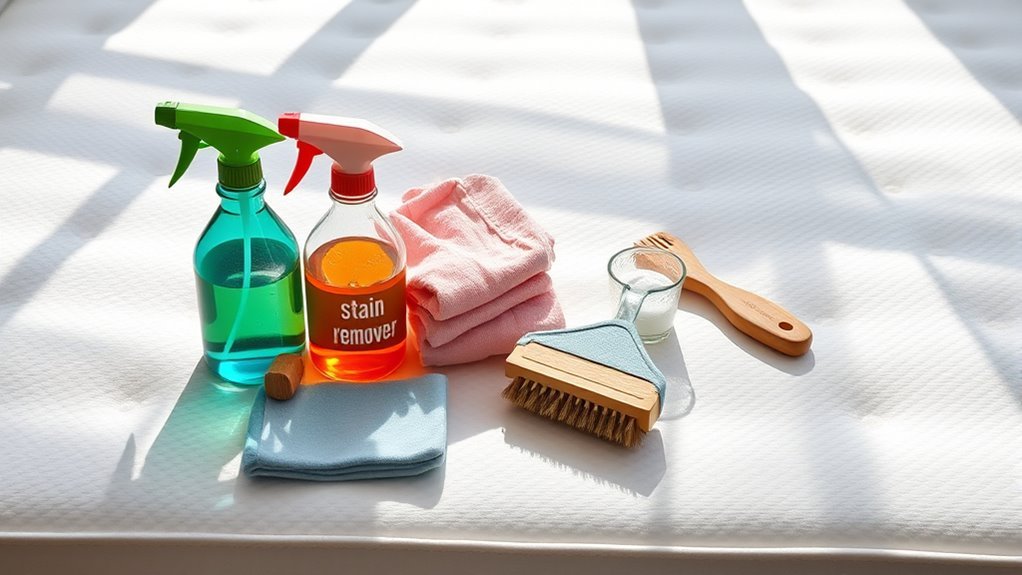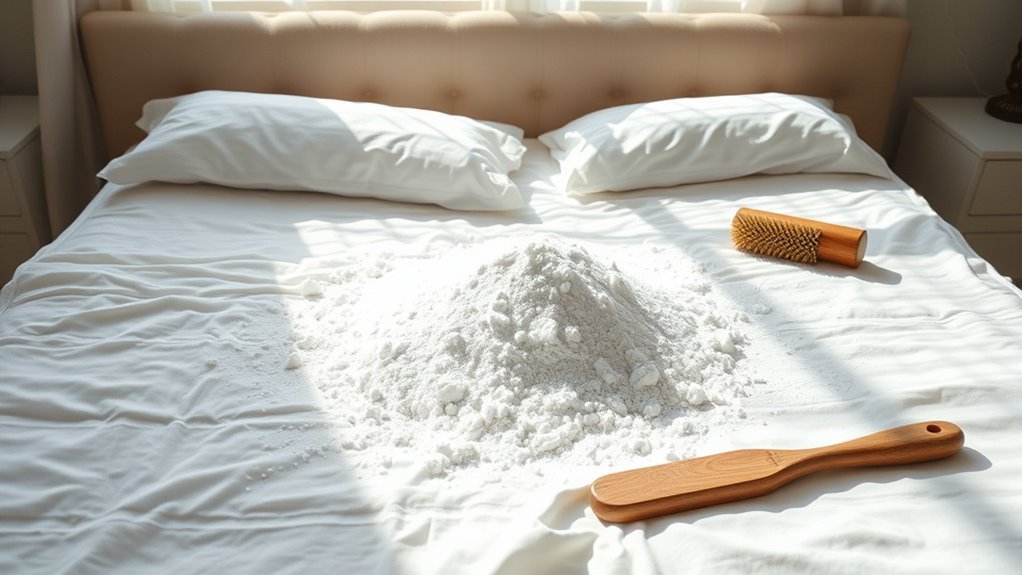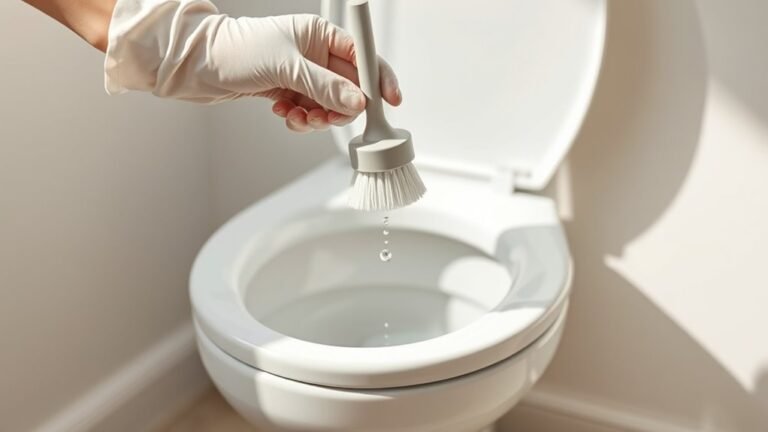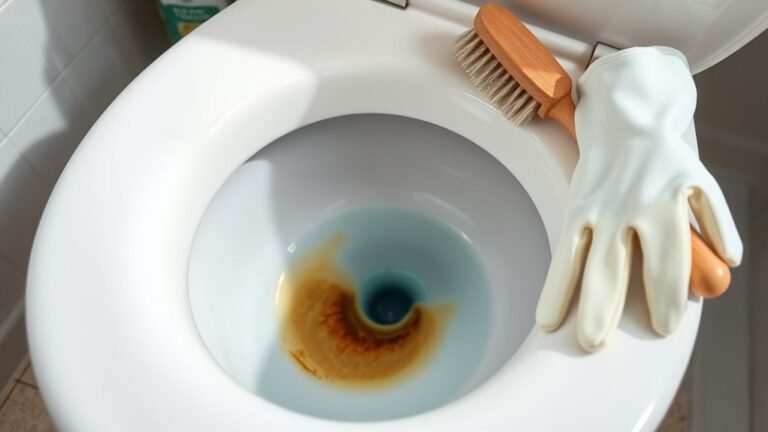How to Clean Mattress
To clean your mattress, first strip the bedding and vacuum it thoroughly, focusing on seams. Spot clean stains with mild detergent or enzyme cleaners depending on the stain type. Deodorize by sprinkling baking soda and let it sit for hours before vacuuming again. Air it out in the sun or a well-ventilated room to freshen up. Rotate it regularly to prevent uneven wear. Keep going, and you’ll discover even more ways to maintain a fresh, comfortable bed.
Gather Cleaning Supplies

Before you begin cleaning your mattress, you’ll need to gather a few essential supplies. Having the right cleaning tools and cleaning solutions on hand will make the process efficient and straightforward, freeing you from frustration. Start with a vacuum cleaner equipped with a hose and upholstery attachment to tackle dust and debris. Next, prepare a gentle cleaning solution—mixing mild detergent with water works well, or you can opt for specialized mattress cleaners if you prefer. You’ll also want a spray bottle for even application, a soft-bristled brush to lift stains without damage, and clean microfiber cloths for blotting and drying. By assembling these basics, you set yourself up for a smooth, liberating cleaning experience that refreshes your mattress without hassle.
Remove Bedding and Vacuum the Mattress
Start by stripping all bedding from your mattress, including sheets, pillowcases, and mattress protectors. This simple step frees you from dirt and allergens trapped in fabrics, setting the stage for a thorough clean. Next, grab your vacuum and attach the upholstery brush—one of the essential cleaning tools for this job. Vacuum the mattress surface gently but thoroughly, paying attention to seams and edges where dust and debris tend to accumulate. Different mattress types—memory foam, innerspring, or latex—require a delicate touch, so avoid harsh pressure that could damage the material. Vacuuming removes dust mites and allergens, giving your mattress a fresh start. Taking these steps regularly keeps your sleeping space clean and liberates you from unseen grime that impacts your health and comfort.
Spot Clean Stains With Appropriate Solutions

While vacuuming removes surface dirt, stubborn stains require targeted treatment to keep your mattress fresh. For effective stain removal, pick cleaning solutions suited to the stain type. Here’s a quick guide:
| Stain Type | Cleaning Solution |
|---|---|
| Blood | Cold water + mild detergent |
| Sweat | Baking soda + water paste |
| Urine | Enzyme cleaner |
| Coffee/Tea | Vinegar + water mixture |
Apply the solution gently with a cloth, avoiding soaking the mattress. Blot stains instead of rubbing to prevent damage. After treating, let the mattress air dry thoroughly. This focused approach frees you from lingering stains and keeps your mattress inviting without harsh chemicals or heavy scrubbing.
Deodorize the Mattress
Though you’ve tackled stains, your mattress can still hold onto odors that affect your sleep quality. To restore mattress freshness and enjoy truly clean rest, focus on odor removal with these simple steps:
- Open windows to air out the room and mattress, letting fresh air circulate freely.
- Use fabric sprays designed for mattresses to neutralize smells without harsh chemicals.
- Sprinkle a small amount of cornstarch lightly; it absorbs lingering odors naturally.
- Place dryer sheets between mattress layers or under the sheets for a subtle, fresh scent.
Deep Clean With Baking Soda

If you want to remove deep-seated dirt and odors, baking soda is your best bet. Sprinkle a generous layer of baking soda evenly over your mattress, focusing on any stained or smelly areas. This natural powder works wonders for deep cleaning by absorbing moisture, neutralizing odors, and loosening dirt trapped inside the mattress fibers. Let it sit for several hours—or even better, overnight—to guarantee thorough absorption. When time’s up, vacuum the mattress carefully to remove all the baking soda along with the lifted grime. This simple deep cleaning step not only refreshes your mattress but also extends its lifespan, giving you the freedom to sleep soundly without worrying about hidden dirt or odors.
Air Out the Mattress
After cleaning, it’s important to air out your mattress to remove moisture and odors. The best time to do this is during dry, sunny hours when ventilation is ideal. You can simply strip the bedding and let fresh air circulate around the mattress for a few hours.
Importance of Ventilation
Since your mattress absorbs moisture and odors over time, proper ventilation is essential to keep it fresh and hygienic. Good air circulation prevents mold and dust mites, ensuring your mattress hygiene stays exceptional. You’ll enjoy a healthier sleeping environment and extend your mattress’s life by letting it breathe regularly.
To maximize ventilation, you can:
- Open windows to boost air flow in your bedroom.
- Remove bedding occasionally to expose the mattress surface.
- Use a fan to promote consistent air movement.
- Elevate the mattress on slatted bed frames for better air circulation underneath.
Best Airing Times
When’s the best time to air out your mattress to keep it fresh? The best seasons for airing are spring and early fall—when the air is crisp, dry, and inviting. These times let you open windows wide without battling extreme heat or cold, giving your mattress the freedom to breathe and release trapped moisture. While summer can work, humidity often slows drying, and winter’s chill isn’t ideal for airflow. You want to choose airing methods that maximize ventilation—like removing bedding and letting fresh air circulate freely around the mattress. Timing your airing sessions during daylight hours guarantees natural warmth boosts evaporation. By syncing your airing routine with the best seasons and smart airing methods, you’ll keep your mattress fresh and ready for restful nights.
Techniques for Airing
Although airing out your mattress might seem straightforward, using the right techniques can make a big difference in how effectively moisture and odors are removed. To maintain mattress freshness, you’ll want to adopt some smart airing techniques that let your mattress breathe freely and reset its environment.
Here’s how you can do it:
- Strip all bedding and let the mattress sit uncovered for several hours.
- Open windows and doors to create a cross breeze, boosting airflow.
- Use a fan to circulate air if natural ventilation is limited.
- Rotate or flip the mattress periodically to expose all sides to fresh air.
Prevent Future Mattress Stains and Odors
To keep your mattress fresh and stain-free, you’ll want to take some proactive steps. Start by investing in high-quality protective covers; they act as a barrier against spills, sweat, and dust mites, making cleanup easier and extending your mattress’s life. You can also apply stain repellents designed specifically for fabrics to add an extra layer of defense. These products help prevent liquids from soaking in, giving you more freedom to enjoy your space without worry. Avoid eating or drinking in bed to minimize risks, and make it a habit to air out your mattress regularly. By combining these simple habits, you’ll maintain a clean, odor-free mattress that supports your freedom to live comfortably every day.
Schedule Regular Mattress Cleaning Sessions
Keeping up with preventative measures is a great start, but you’ll also want to set a routine for deep cleaning your mattress. Establishing a regular mattress cleaning frequency helps you maintain freshness, extend mattress life, and create a healthier sleep space. The cleaning schedule benefits go beyond cleanliness—they give you peace of mind and freedom from allergens. Here’s how to make it easy:
- Choose a consistent interval, like every three to six months
- Mark your calendar as a reminder to stay on track
- Combine vacuuming, spot cleaning, and deodorizing during each session
- Inspect for stains or damage to address issues promptly
Frequently Asked Questions
How Often Should I Replace My Mattress?
You should consider your mattress lifespan, which typically ranges from 7 to 10 years. If you notice signs of replacement like sagging, lumps, or increased allergies, it’s time to let go. Don’t feel trapped by old bedding; upgrading can free you from restless nights and discomfort. Trust your body’s signals—when your mattress no longer supports you like it used to, replacing it will bring you the freedom of better sleep and renewed energy.
Can Mattress Cleaning Improve Sleep Quality?
Absolutely, mattress cleaning can boost your sleep quality by enhancing sleep hygiene. When your mattress is clean, you reduce allergens, dust mites, and bacteria, which often disrupt your rest. This means you can breathe easier and feel more comfortable, leading to a freer, more revitalizing sleep experience. Embracing these cleaning benefits helps you create a healthier sleep environment, so you wake up feeling truly liberated and energized each day.
Are Mattress Protectors Necessary for Allergy Sufferers?
If you suffer from allergies, mattress protectors are definitely worth it. They provide allergen reduction by creating a barrier against dust mites and other irritants that can trigger symptoms. You’ll enjoy greater freedom from sneezing and itching, allowing you to sleep more comfortably. Plus, mattress protectors help with dust mite prevention, keeping your sleeping space cleaner and healthier without restricting your lifestyle. They’re a simple, effective solution for allergy relief.
How Do I Know if My Mattress Is Too Old?
Isn’t it frustrating when your mattress feels like a bed of nails? If you notice signs of wear like sagging, lumps, or visible stains, it’s a red flag. Sleep disturbances—waking up sore or restless—also signal your mattress might be past its prime. You deserve freedom from discomfort, so don’t ignore these clues. Typically, if it’s over 7-10 years old, it’s time to contemplate a fresh start for better rest and liberation.
Can Mattress Cleaning Help With Bed Bugs?
Yes, cleaning your mattress can help reduce bed bug presence, but it’s not a complete solution. You’ll want to vacuum thoroughly, using prevention techniques like encasing your mattress in a bed bug-proof cover and regularly washing bedding in hot water. These steps give you freedom from pests without harsh chemicals. Remember, combining cleaning with prevention techniques is key to keeping bed bugs at bay and reclaiming your peaceful sleep space.






